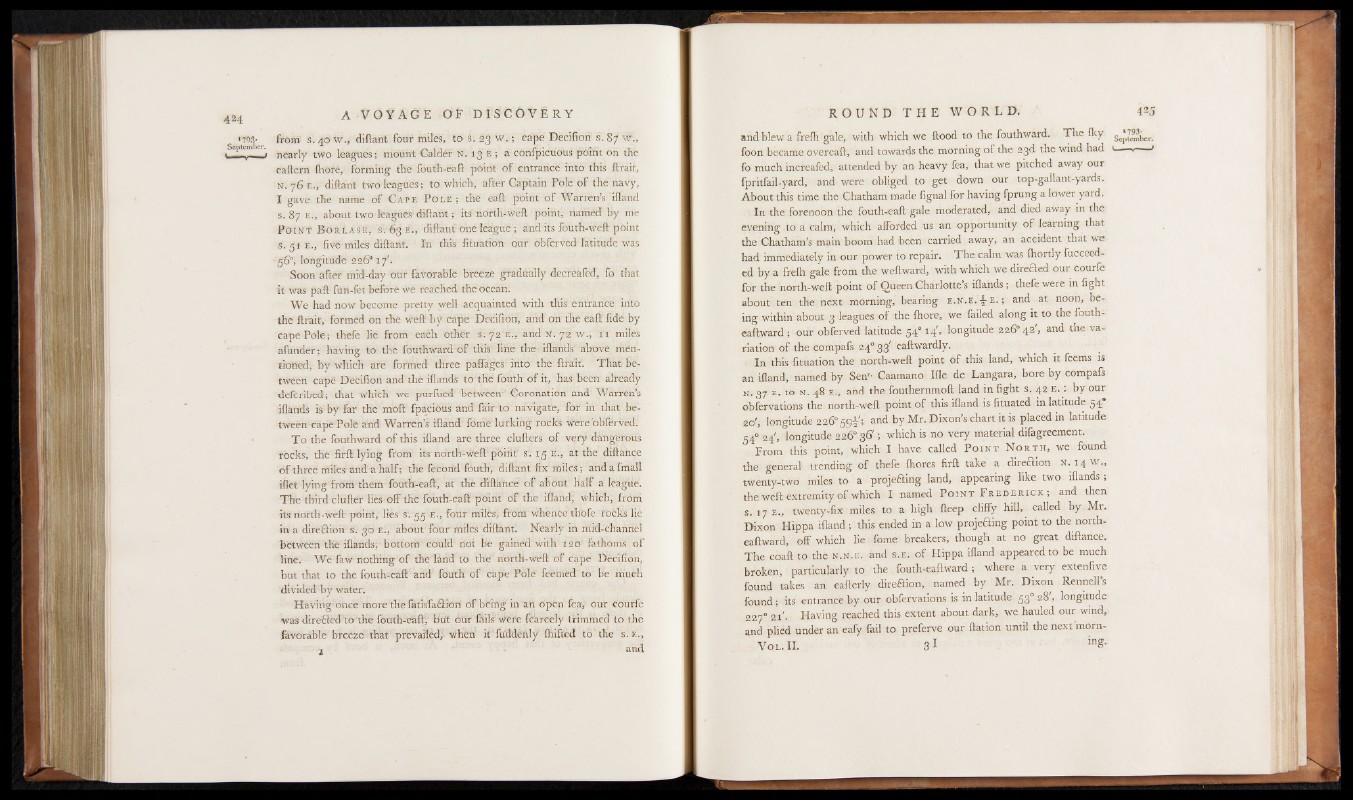
«79»r from S.40W., diftant four miles, to S. 23 w . ; cape Decifion s. 87 vit.,
September two leagues ; mount Caldér N. 13 é ; a conspicuous point on the
eallern Ihore, forming the fouth-eafl point o f entrance into this lirait,
n . 76 e ., diftant two leagues ; to which, after Captain Pole o f thé navy,
I gave the name of C a p e P o l e ; the eaft point o f Warren’s 'ifland
s. 87 e . , about two leagues' diftant ; its north-Weft point, named by me
P o i n t B o r l a s -e , s . S3 e ., diftant one league ; and its fouth-weft point
s'. 51 e ., five miles diftant. In this- fituatibn our obferved latitude was.
56“, longitude 226° 17'.
Soon after mid-day our favorable breeze gradually decrèafed, fo that
it was paft fun-fet before we reached the ocean.
We had now become pretty well acquainted with this entrance into
the lirait, formed on the weft bÿ cape Decifion, and' on the eaft fide by
cape Pole; thefe lie from* each other s: 72 e ., and n. 72 w.; f i miles
afunder; having to the fouthward'of this line the iflands above mentioned.
by which are formed three paffages iritb' the lirait. That between
cape Decifion and the iflands to-the fouth o f it, has been already
deferibed; that which we purfued between- Coronation and'Warren’s
iflands is by far the moll fpacioüs and fair to navigate, for in that between
cape Pole and Warren’s ifland fdme lurking rocks Wère ObférVed.
T o the fouthward o f this ifland are three clufters of very dà'ngéfotis
rocks; the firft lying from its north-Weft'pbirit's. 15 É., at the diftance
o f three miles and a half; the feCond fouth, diftant fix miles'; and a final!
iflet lying from them fouth-eaft, at the diftance o f about Half a league.
The third duller lies-off the fouth-eaft1 point o f the ifland, which, Iroiii
its north-weft point, lies s; 5 5 -e ., four milès, from whence thole rock’s lié
in a direftion S. 30 e . , about four miles'diftant. Nearly in mid-channel
between the iflands;-bottom could not be gained with T 20 fathoms of
line. We faw nothing of the land to the'north-weft o f cape Decifion,
but that to the fouth-eaft'and fouth o f cape Pole feéméd to be much
divided by water.
Having-once more the fàtisfaSiori of being in an open Tea!,- our courfe
was direQed to the fouth-éàlP,' b’Ut bur fails' were fèàrcely trimmed' to the
favorable breeze that prevailed,*■ when it fu'ddènly fluffed to'the s . e .,
and
and blew a frelh gale, with which we Hood to the fouthward. The Iky September,
foon became overcaft, and towards the morning o f the 23d the wind had ■
lo much increafed, attended by an heavy lea, that we pitched away our
fpritfail-yard, and were obliged to get down our top-gallant-yards.
About this time the Chatham made fignal for having fprung a lower yard.
In the forenoon the fouth-eaft gale moderated, and died away in the
evening to a calm, which afforded us an opportunity o f learning that
the Chatham’s main boom had been carried away, an accident that we
had immediately in our power to repair. The calm was Ihortly fuCceed-
ed by a frelh gale from the weftward, with which we direfted our courfe
for the north-weft point of Queen Charlotte s iflands; thefe were in fight
about ten the next morning, bearing e .n . e .U-e . ; and at noon, being
within about 3 leagues of the Ihore, we failed along it to the fouth-
caftward ; our obferved latitude 540 14', longitude 226° 42', and the variation
o f the compafs 24” 33' eallwardly.
In this flotation the north-weft point o f this land, which it feems is
an ifland, named by Sen- Caamano Ifle de Langara, bore by compafs
n . 37 e . to n . 48 e ., and the fouthernmoll land in fight s. 42 e . : by our
obfervations the north-weft point of this ifland is fituated in latitude 34
2o’, longitude 226°59%'; and by Mr. Dixons chart it is placed in latitude
540 24', longitude 226° 36'; which is no very material difagreement.
From this point, which I have called P o i n t N o r t h , we found
the general trending of thefe Ihores firft take a direction N. 14 w „
twenty-two miles to a projefting land, appearing like two iflands;
the well extremity of which I named P o i n t F r e d e r i c k ; and then
s. 17 e ., twenty-fix miles to a high fteep cliffy hill, called by,Mr .
Dixon Hippa ifland; this ended in a low projecting point to the north-
eaftward, off which lie fome breakers, though at no great diftance.
The coaft to the n .n .e . and s. e . of Hippa ifland appeared to be much
broken, particularly to the fouth-eaftward ; where a very extenfive
found takes an eallerly direftion, named by Mr. Dixon Rennell’s
found; its entrance by our obfervations is in latitude 53° 28', longitude
2270 21'. Having reached this extent about dark, we hauled our wind,
and plied under an eafy fail to preferve our ftation until the next morn-
V o L .I I . 3 1 inS’